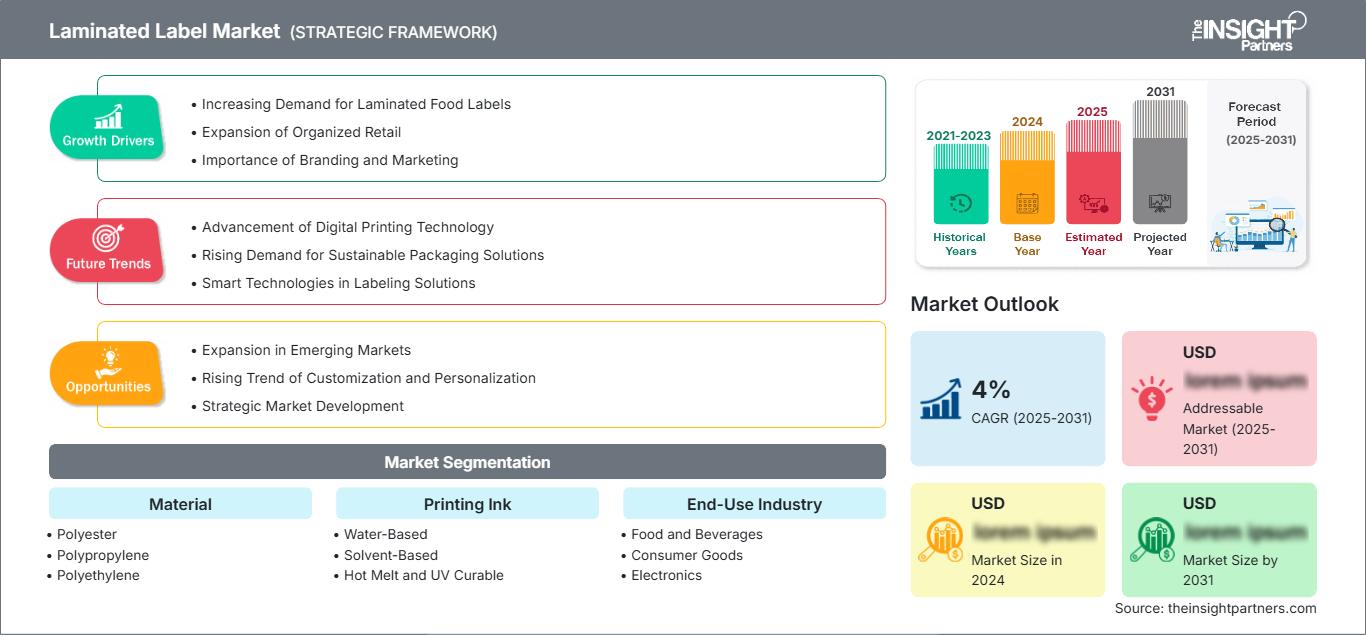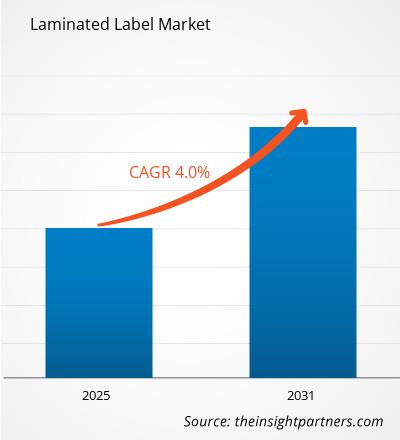Der Markt für laminierte Etiketten wird voraussichtlich zwischen 2025 und 2031 eine durchschnittliche jährliche Wachstumsrate (CAGR) von 4 % verzeichnen, wobei die Marktgröße von XX Millionen US-Dollar im Jahr 2024 auf XX Millionen US-Dollar im Jahr 2031 anwachsen wird.
Der Bericht ist nach Material (Polyester, Polypropylen, Polyethylen, Vinyl und andere) und Druckfarbe (auf Wasserbasis, auf Lösungsmittelbasis, Schmelzklebstoff und UV-härtbar) segmentiert. Der Bericht enthält außerdem eine Analyse basierend auf der Endverbrauchsbranche (Lebensmittel und Getränke, Konsumgüter, Elektronik, Körperpflege und Kosmetik, Pharmazeutika und andere). Die globale Analyse ist weiter auf regionaler Ebene und nach wichtigen Ländern aufgeschlüsselt. Der Umfang umfasst die Marktgröße und -prognose auf globaler, regionaler und Länderebene für alle wichtigen Marktsegmente. Der Bericht bietet den Wert in USD für die oben genannte Analyse und Segmente. Der Bericht enthält wichtige Statistiken zum Marktstatus der wichtigsten Marktteilnehmer und bietet Markttrends und -chancen.
Zweck des Berichts
Der Bericht „Laminated Label Market“ von The Insight Partners beschreibt die aktuelle Situation und das zukünftige Wachstum sowie die wichtigsten treibenden Faktoren, Herausforderungen und Chancen. Dadurch erhalten verschiedene Geschäftsinteressenten Einblicke, wie z. B.:
- Technologieanbieter/-hersteller: Um die sich entwickelnde Marktdynamik zu verstehen und die potenziellen Wachstumschancen zu erkennen, damit sie fundierte strategische Entscheidungen treffen können.
- Investoren: Um eine umfassende Trendanalyse hinsichtlich der Marktwachstumsrate, der finanziellen Marktprognosen und der Chancen entlang der Wertschöpfungskette durchzuführen.
- Regulierungsbehörden: Um Richtlinien und Überwachungsaktivitäten auf dem Markt zu regulieren, mit dem Ziel, Missbrauch zu minimieren, das Vertrauen der Investoren zu wahren und die Integrität und Stabilität des Marktes aufrechtzuerhalten.
Marktsegmentierung für laminierte Etiketten: Material
- Polyester
- Polypropylen
- Polyethylen
- Vinyl und andere
Druckfarbe
- Wasserbasiert
- Lösungsmittelbasiert
- Hotmelt und UV-härtbar
Endverbraucherindustrie
- Lebensmittel und Getränke
- Konsumgüter
- Elektronik
- Körperpflege und Kosmetik
- Pharmazeutika und andere
Geografie
- Nordamerika
- Europa
- Asien-Pazifik
- Süd- und Mittelamerika
- Naher Osten und Afrika
Sie erhalten kostenlos Anpassungen an jedem Bericht, einschließlich Teilen dieses Berichts oder einer Analyse auf Länderebene, eines Excel-Datenpakets sowie tolle Angebote und Rabatte für Start-ups und Universitäten.
Markt für laminierte Etiketten: Strategische Einblicke

- Holen Sie sich die wichtigsten Markttrends aus diesem Bericht.Dieses KOSTENLOSE Beispiel umfasst Datenanalysen, die von Markttrends bis hin zu Schätzungen und Prognosen reichen.
Wachstumstreiber für laminierte Etiketten
- Steigende Nachfrage nach laminierten Lebensmitteletiketten: Die Lebensmittel- und Getränkebranche ist besonders an laminierten Etiketten interessiert. Angesichts der detaillierten Regeln und Vorschriften zur Lebensmittelkennzeichnung suchen Hersteller nach hochwertigen und langlebigen Etiketten, die selbst den härtesten Bedingungen wie Wasser, Hitze und Reibung standhalten. Dank der abriebfesten Eigenschaften laminierter Etiketten bleiben wichtige Produktinformationen über die gesamte Lebensdauer erhalten. Da immer mehr Verbraucher bereits verpackte und verarbeitete Lebensmittel bevorzugen, wird für den Markt für laminierte Etiketten ein rasantes Wachstum prognostiziert.
- Expansion des organisierten Einzelhandels: Die Expansion des Einzelhandels und des E-Commerce hat die Marktchancen für laminierte Etiketten weiter eingeschränkt. Der Trend zum Online-Shopping hat die Nachfrage nach Etiketten erhöht, insbesondere im Hinblick auf Produktbranding und -identifizierung während des Warentransports. Der Anwendungsbereich laminierter Etiketten beschränkt sich nicht nur auf den funktionalen Einsatz, sondern erstreckt sich auch auf Werbemaßnahmen. Die Lockerung der Werbebeschränkungen und die Notwendigkeit bildlicher, auffälliger und manipulationssicherer Schilderkennzeichnungen auf Produkten, die direkt über das Internet an Verbraucher verkauft werden, beflügeln die Aktivitäten in vielen Einzelhandelssegmenten.
- Bedeutung von Branding und Marketing: Branding und Marketing sind zu einem der wichtigsten Faktoren geworden, die Verbraucher auf dem aktuellen Markt zum Kauf eines Artikels motivieren. Aus diesem Grund haben Unternehmen begonnen, bessere und attraktivere Etiketten für ihre Produkte herzustellen, um ihre Konkurrenten zu übertreffen. Laminierte Etiketten sehen edel aus und sind in verschiedenen Farben, Strukturen und Ausführungen erhältlich, die die gesamte Verpackung aufpeppen können. Dies ist in der Kosmetik- sowie der Körper- und Haushaltspflegeproduktbranche und dort, wo der Bedarf an laminierten Etikettierlösungen steigt, noch ausgeprägter.
Markttrends für laminierte Etiketten
- Fortschritt der Digitaldrucktechnologie: Der Wandel in der Branche für laminierte Etiketten wurde durch den Fortschritt der Digitaldrucktechnologie erheblich beeinflusst. Es ermöglicht die schnelle Produktion selbst kleinster Schildersammlungen mit Bildern und leuchtenden Farben. Der Digitaldruck ermöglicht Herstellern eine effiziente individuelle Etikettengestaltung für ihre Kunden, die Etiketten aller Art benötigen. Die Möglichkeit, kundenspezifische Etikettenprodukte zu geringen oder keinen Einrichtungskosten anzubieten, revolutioniert diesen Markt und macht ihn für kleine Unternehmen und Start-ups attraktiv.
- Steigende Nachfrage nach nachhaltigen Verpackungslösungen: Da die globale Erwärmung immer wichtiger wird, tendiert auch der Markt für klassisch laminierte Etiketten dazu, eine neue Generation umweltfreundlicher Laminieretiketten zu produzieren. Immer mehr Hersteller setzen auf fortschrittliche, recycelbare Materialien, beispielsweise abbaubare Folien und biologisch abbaubare Klebstoffe, um Etiketten herzustellen, die weniger umweltschädlich sind. Diese Aspekte zu berücksichtigen, entspricht nicht nur den Bedürfnissen der Kunden nach umweltfreundlicheren Produkten, sondern reagiert auch auf die steigenden Nachhaltigkeitsanforderungen der Behörden. Dies wiederum verstärkt das Interesse und den Fokus auf die Erweiterung von Etikettierlösungen um nachhaltige Funktionen, was den Wettbewerb auf dem Markt für laminierte Etikettierlösungen verschärft.
- Intelligente Technologien in Etikettierlösungen: Ein aufkommender Trend auf dem Markt für laminierte Etiketten ist die Überschneidung intelligenter Technologien mit den Etikettierlösungen. Durch die Implementierung solcher Systeme können Verpackungen mit intelligenten Etiketten versehen werden, die QR-Codes, NFC-Tags oder RFID-Chips enthalten, sodass die Marke Informationen über das Produkt bereitstellen und sogar mit dem Verbraucher interagieren kann. Dies bietet einen Mehrwert bei der Verwendung laminierter Etiketten, da Unternehmen so Artikel auf Lager verwalten, Produktaufzeichnungen führen und Kundendaten erfassen können. Mit der zunehmenden Verbreitung intelligenter Technologien wachsen auch die Möglichkeiten, laminierte Etiketten für ihre verbesserten Funktionen zu nutzen.
Marktchancen für laminierte Etiketten
- Expansion in Schwellenmärkten: Es ist ein guter Zeitpunkt für Hersteller laminierter Etiketten, in neue Gebiete vorzudringen, insbesondere im asiatisch-pazifischen Raum, in Lateinamerika und Afrika. Aufgrund der raschen Urbanisierung und der Verbesserung der wirtschaftlichen Lage der Bevölkerung sowie der entstehenden Mittelschicht steigt in diesen Gebieten die Nachfrage nach verpackten Produkten und effektiven Etikettiersystemen. Durch entsprechende Produktlokalisierung und die Zusammenarbeit mit lokalen Vertriebshändlern können lokale Märkte erfolgreich erschlossen werden.
- Steigender Trend zu Individualisierung und Personalisierung: Der Markt für laminierte Etiketten wird erheblich vom anhaltenden Wandel bei Geschmack und Vorlieben hin zur Massenindividualisierung und Personalisierung von Produkten profitieren. Heutzutage lässt sich immer häufiger beobachten, dass Marken einzigartige Etikettierlösungen wünschen, die sich von allen anderen abheben und eine bemerkenswerte Verbindung zu den Verbrauchern herstellen. Für Hersteller ist dies ein wichtiger Faktor, da sie Optionen zur Individualisierung wie variablen Datendruck, unterschiedliche Formen und Texturen anbieten können. Dies trägt dazu bei, die Markentreue im Verbrauchermarkt aufzubauen und das Markenmanagement zu unterstützen.
- Strategische Marktentwicklung: Für Hersteller laminierter Etiketten gibt es viele Möglichkeiten, ihr Geschäft auszubauen, beispielsweise durch Fusionen und Übernahmen oder strategische Allianzen mit Unternehmen aus den Bereichen Verpackung, Logistik oder Einzelhandel. Beispielsweise kann die Zusammenarbeit mit einem Verpackungsunternehmen oder einem E-Commerce-Unternehmen es den Unternehmen ermöglichen, Verpackungsdienstleistungen anzubieten, bei denen laminierte Etiketten in die Verpackungslieferkette integriert werden. Durch die Ausrichtung auf diese spezielle Gruppe können die Unternehmen ihre Sichtbarkeit auf dem lokalen Markt erhöhen und die richtigen Produkte entsprechend den Trends, Entwicklungen und Marktbedürfnissen bewerben.
Markt für laminierte Etiketten
Die Analysten von The Insight Partners haben die regionalen Trends und Faktoren, die den Markt für laminierte Etiketten im Prognosezeitraum beeinflussen, ausführlich erläutert. In diesem Abschnitt werden auch die Marktsegmente und die geografische Lage in Nordamerika, Europa, dem asiatisch-pazifischen Raum, dem Nahen Osten und Afrika sowie Süd- und Mittelamerika erörtert.Umfang des Marktberichts für laminierte Etiketten
| Berichtsattribut | Einzelheiten |
|---|---|
| Marktgröße in 2024 | US$ XX million |
| Marktgröße nach 2031 | US$ XX Million |
| Globale CAGR (2025 - 2031) | 4% |
| Historische Daten | 2021-2023 |
| Prognosezeitraum | 2025-2031 |
| Abgedeckte Segmente |
By Material
|
| Abgedeckte Regionen und Länder | Nordamerika
|
| Marktführer und wichtige Unternehmensprofile |
|
Dichte der Marktteilnehmer für laminierte Etiketten: Verständnis ihrer Auswirkungen auf die Geschäftsdynamik
Der Markt für laminierte Etiketten wächst rasant. Die steigende Nachfrage der Endverbraucher ist auf Faktoren wie veränderte Verbraucherpräferenzen, technologische Fortschritte und ein stärkeres Bewusstsein für die Produktvorteile zurückzuführen. Mit der steigenden Nachfrage erweitern Unternehmen ihr Angebot, entwickeln Innovationen, um den Bedürfnissen der Verbraucher gerecht zu werden, und nutzen neue Trends, was das Marktwachstum weiter ankurbelt.

- Holen Sie sich die Markt für laminierte Etiketten Übersicht der wichtigsten Akteure
Wichtige Verkaufsargumente
- Umfassende Abdeckung: Der Bericht analysiert umfassend Produkte, Dienstleistungen, Typen und Endnutzer des Marktes für laminierte Etiketten und bietet einen ganzheitlichen Überblick.
- Expertenanalyse: Der Bericht basiert auf dem umfassenden Verständnis von Branchenexperten und Analysten.
- Aktuelle Informationen: Der Bericht gewährleistet Geschäftsrelevanz durch die Berichterstattung über aktuelle Informationen und Datentrends.
- Anpassungsoptionen: Dieser Bericht kann an spezifische Kundenanforderungen angepasst werden und passt sich so optimal an die Geschäftsstrategien an.
Der Forschungsbericht zum Markt für laminierte Etiketten kann daher dazu beitragen, die Branchensituation und die Wachstumsaussichten zu entschlüsseln und zu verstehen. Obwohl es einige berechtigte Bedenken geben mag, überwiegen die Vorteile dieses Berichts tendenziell die Nachteile.
- Historische Analyse (2 Jahre), Basisjahr, Prognose (7 Jahre) mit CAGR
- PEST- und SWOT-Analyse
- Marktgröße Wert/Volumen – Global, Regional, Land
- Branchen- und Wettbewerbslandschaft
- Excel-Datensatz
Aktuelle Berichte
Verwandte Berichte
Erfahrungsberichte
Grund zum Kauf
- Fundierte Entscheidungsfindung
- Marktdynamik verstehen
- Wettbewerbsanalyse
- Kundeneinblicke
- Marktprognosen
- Risikominimierung
- Strategische Planung
- Investitionsbegründung
- Identifizierung neuer Märkte
- Verbesserung von Marketingstrategien
- Steigerung der Betriebseffizienz
- Anpassung an regulatorische Trends




















 Kostenlose Probe anfordern für - Markt für laminierte Etiketten
Kostenlose Probe anfordern für - Markt für laminierte Etiketten